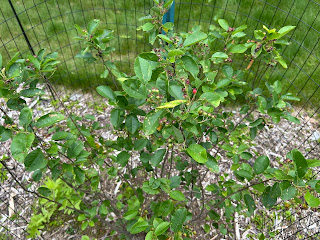 |
| A butterfly visiting as seen through the dining room window yesterday |
We have planted several native shrubs over the past year or so in our front yard. We have started replacing some of our front lawn with what we are calling the "Shrub Garden." Also, last summer, before the house was painted, we removed a dead shrub that had been a part of the established foundation plantings which include several hybrid rhododendrons and ornamental evergreen shrubs.
Last fall after the painters were done, we planted a Virginia sweetspire, Itea virginica, to replace the shrub that we had removed. It seems to be settling in. It gets full sun in the morning, but afternoon shade from the house. Yesterday, while in the dining room, we noticed a butterfly on it. At first I suspected that the butterfly was a swallowtail, but Renee identified it correctly as a red-spotted purple, Limenitis arthemis astyanax. They have evolved to mimic pipevine swallowtails since the swallowtails are not palatable to birds. The red-spotted purple caterpillars have also evolved to mimic, wait for it, bird poop. I guess another example of less than palatable food for birds. Black cherry trees are a host to the red-spotted purple, and we have one on our property and several in the woods surrounding us.
 |
| Serviceberry in June 2025 |
We started our "Shrub Garden" when we planted this serviceberry, Amelanchier x grandiflora 'Autumn Brilliance,' in the fall of 2023. When we planted it, we used cardboard and wood chip mulch to start the garden. We also put a wire fence around it to protect it from the critters. It has flowered each May since then, and this summer we have seen catbirds and goldfinches eating berries from it.
 |
| The summersweet finally leafed out |
Last fall, we expanded
the mulched area and planted a summersweet, Clethra alnifolia. We left it in its pot for a long time after we bought it and let it get a bit dry, so we were worried when it didn't leaf out when the other shrubs did this spring. Now we realize that it just leafs out really late. It flowers later in the summer, but it is a long bloomer and very popular with the pollinators. Renee is planning on planting some golden alexanders and columbine here between the shrubs, but we have so much to do in the knotweed expanse that it might not happen this year.
 |
| Common snowberry island in the lawn, 2025 |
The third shrub in the nascent shrub garden is the common snowberry, Symphoricarpos albus. We planted it last fall, and as can be seen in the photo, we haven't expanded the lasagna cardboard and mulch to it yet. Also, we need to be aware that it is susceptible to deer browse, and we don't have a cage around it. At the least it should be a target of spraying with a deer repellant. We have a lot of seedlings to plant now, but later this summer, I would like to complete the shaping and smothering of the lawn with cardboard and mulch for this garden bed with its native shrubs.





